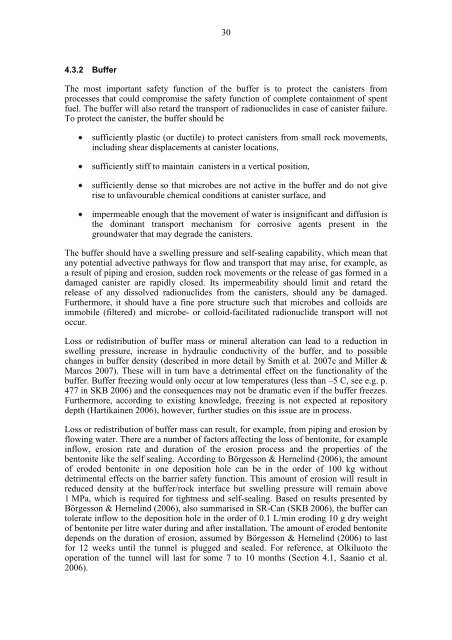RSC-Programme - Interim Report. Approach and Basis for - Posiva
RSC-Programme - Interim Report. Approach and Basis for - Posiva
RSC-Programme - Interim Report. Approach and Basis for - Posiva
You also want an ePaper? Increase the reach of your titles
YUMPU automatically turns print PDFs into web optimized ePapers that Google loves.
304.3.2 BufferThe most important safety function of the buffer is to protect the canisters fromprocesses that could compromise the safety function of complete containment of spentfuel. The buffer will also retard the transport of radionuclides in case of canister failure.To protect the canister, the buffer should besufficiently plastic (or ductile) to protect canisters from small rock movements,including shear displacements at canister locations,sufficiently stiff to maintain canisters in a vertical position,sufficiently dense so that microbes are not active in the buffer <strong>and</strong> do not giverise to unfavourable chemical conditions at canister surface, <strong>and</strong>impermeable enough that the movement of water is insignificant <strong>and</strong> diffusion isthe dominant transport mechanism <strong>for</strong> corrosive agents present in thegroundwater that may degrade the canisters.The buffer should have a swelling pressure <strong>and</strong> self-sealing capability, which mean thatany potential advective pathways <strong>for</strong> flow <strong>and</strong> transport that may arise, <strong>for</strong> example, asa result of piping <strong>and</strong> erosion, sudden rock movements or the release of gas <strong>for</strong>med in adamaged canister are rapidly closed. Its impermeability should limit <strong>and</strong> retard therelease of any dissolved radionuclides from the canisters, should any be damaged.Furthermore, it should have a fine pore structure such that microbes <strong>and</strong> colloids areimmobile (filtered) <strong>and</strong> microbe- or colloid-facilitated radionuclide transport will notoccur.Loss or redistribution of buffer mass or mineral alteration can lead to a reduction inswelling pressure, increase in hydraulic conductivity of the buffer, <strong>and</strong> to possiblechanges in buffer density (described in more detail by Smith et al. 2007c <strong>and</strong> Miller &Marcos 2007). These will in turn have a detrimental effect on the functionality of thebuffer. Buffer freezing would only occur at low temperatures (less than –5 C, see e.g. p.477 in SKB 2006) <strong>and</strong> the consequences may not be dramatic even if the buffer freezes.Furthermore, according to existing knowledge, freezing is not expected at repositorydepth (Hartikainen 2006), however, further studies on this issue are in process.Loss or redistribution of buffer mass can result, <strong>for</strong> example, from piping <strong>and</strong> erosion byflowing water. There are a number of factors affecting the loss of bentonite, <strong>for</strong> exampleinflow, erosion rate <strong>and</strong> duration of the erosion process <strong>and</strong> the properties of thebentonite like the self sealing. According to Börgesson & Hernelind (2006), the amountof eroded bentonite in one deposition hole can be in the order of 100 kg withoutdetrimental effects on the barrier safety function. This amount of erosion will result inreduced density at the buffer/rock interface but swelling pressure will remain above1 MPa, which is required <strong>for</strong> tightness <strong>and</strong> self-sealing. Based on results presented byBörgesson & Hernelind (2006), also summarised in SR-Can (SKB 2006), the buffer cantolerate inflow to the deposition hole in the order of 0.1 L/min eroding 10 g dry weightof bentonite per litre water during <strong>and</strong> after installation. The amount of eroded bentonitedepends on the duration of erosion, assumed by Börgesson & Hernelind (2006) to last<strong>for</strong> 12 weeks until the tunnel is plugged <strong>and</strong> sealed. For reference, at Olkiluoto theoperation of the tunnel will last <strong>for</strong> some 7 to 10 months (Section 4.1, Saanio et al.2006).
















